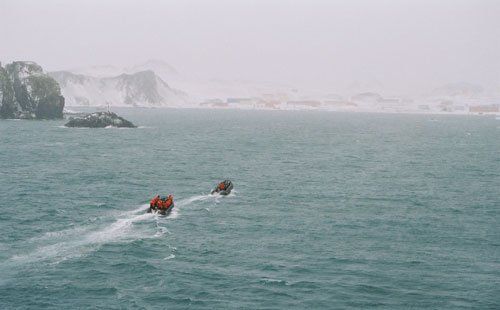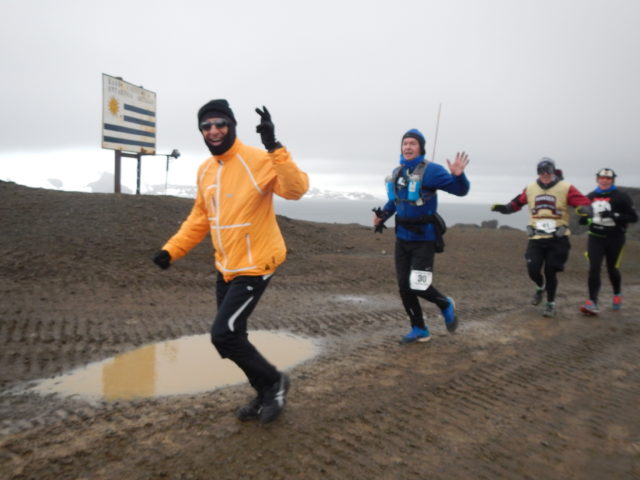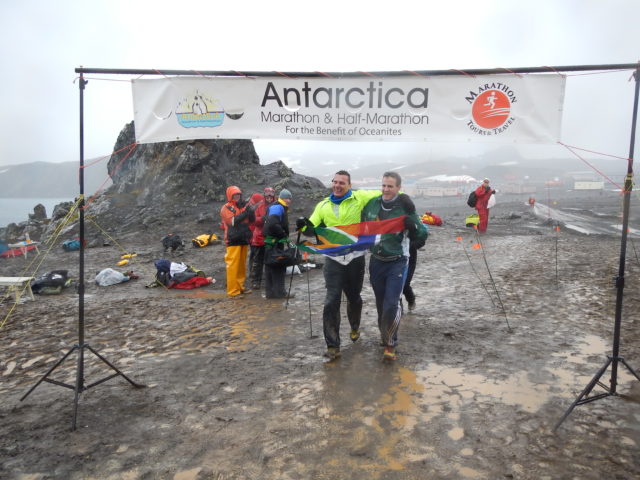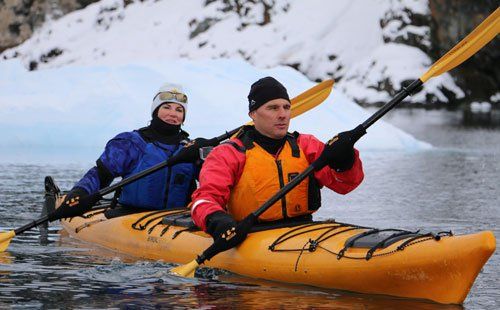
The Antarctica Marathon is billed as one of the most grueling marathons in the world. Having run it twice and worked it five times, my experience is that the challenge comes not just from the event itself, but from the culmination of sensational variables.
For starters, it’s the world’s most challenging taper. Take a nervous runner, put them on three or more flights lasting a total of 15-24 hours to the southernmost city in the world – Ushuaia. Add a dose of sea-sickness from crossing the Drake Passage (the roughest seas in the world) on a Russian research ship for two and a half days and top it off with the inability to run for several days before the race (and the inability to shop to soothe the symptoms of taper madness).
Then, there’s the 20-minute Zodiac boat ride to shore where you dress in wet skins and hope you don’t get wet pre-race. Oh and let’s not forget, you’re off the grid without wifi or selfies for 10 days (although most see that as a benefit these days). In essence, the race begins the minute you leave the comforts of your home and ends in triumph the minute you cross the finish line in Antarctica.

The racecourse is typically defined as brutal, including ankle-deep mud, ice, snow, mammoth hills, and a constant and exhaustive headwind that can blow from 20-40 miles per hour. When you finish the Antarctica Marathon, you’re completely spent from having to think about and plan every step of the course. One minute you’re running on a slippery, muddy hill and the next you’re attempting to jump across a stream that, as time passes, turns into a river.
It’s not for the faint of heart. It’s for runners who want to venture off the beaten path, expand their mental and physical limits, and conquer something truly epic. With that description who in their right mind would want to run the Antarctica Marathon – right? It’s quite the contrary, the event has gotten so popular, it’s sold out through 2016. Every year the event draws an adventurously fit group of runners from all over the world. This year was no different with 200 runners representing 22 countries. It’s a little like being at the adventure-running Olympics.
There are runners who are aiming to finish a marathon on all seven continents and many who have run hundreds of marathons. In fact, we tallied the total number of marathons and ultra’s run on our ship of 100 runners, and it added up to over 4,000! I continue to be enamored of the vastness of Antarctica, but I’m always surprised and humbled by the runners on this journey. Their stories are every bit as grand as the Antarctica scenery.
Blind adventure athlete Hein Wagner is one of these people. He not only finished the world’s toughest marathon without sight to navigate the harsh terrain, he did so without his go-to running partner and guide Mike Bailey. Just three weeks prior to the race, Mike developed an injury that wouldn’t allow him to run with Hein. As luck would have it, Nick Kruiskamp, a brother of another participant, registered for the marathon and volunteered to guide Hein. Amazingly, the Antarctica Marathon was their first run together.
The terrain was also a surprising challenge. “When I started training for the Antarctica Marathon, I decided I wasn’t going to train on trails because every time I run on a trail my risk for an ankle injury is very high,” explained Wagner. He instead focused on training on hilly, dirt roads where he could get used to the dirt, sand, and stones with less risk of injuries.
The key to being a successful adventure athlete is the ability to adapt. This is clearly one of Hein’s greatest assets and the foundation of all his world adventures. Where a sighted runner will navigate the demanding marathon course primarily by their vision, Hein does so with his hearing and sense of spatial perception. “In a road race, I listen to the runners ahead of us to create a line of movement. In Antarctica, the winds were so harsh, I couldn’t use this strategy and had to rely more on Nick’s body movements,” explains Wagner. He feels the way Nick lifts his feet as they roll through the never-ending hills. When his feet lift higher, so does his elbow signaling a shift in the terrain’s incline.
The marathon is one loop course that is repeated three times which in the end, helped Hein learn the course. His special memory is astounding as he was able to navigate the entire ship after only one tour of the layout. Nick led Hein through the first loop, explaining every obstacle while learning how to guide a blind runner along the way. He quickly learned it was going to be a lot more demanding as his heart rate was skyrocketing from the demands of running, verbalizing, and stabilizing Hein. “After the first loop, I knew the course, and we had to focus on getting Nick’s heart rate lowered to finish the race,” explained Wagner. He directed him to only talk him through the significant obstacles and that allowed them to find a more comfortable rhythm.

“The first loop I guided Hein through the obstacles, but when we hit the second and third loops, he told me he had it and that he knew the course,” said Kruiskamp. “Amazingly, Hein started guiding me in the later stages of the race. I was cramping due to the altered running stride while guiding, and his strength carried me through to the finish.” As they crossed the finish line Hein was filled with emotion, pride, and gratitude for everyone that helped him achieve his goal to be the first blind person to complete the Antarctica Marathon.
If that isn’t enough to make you admire this courageous adventurer, Hein also raised over $100,000 for his foundation, the VisionTrust, which he started in 2007 to make the world a more accessible place for persons living with disabilities and to promote the integration of disabled persons into the workplace, athletics, and the arts. Hein explored the Antarctic waters via kayak where he began to define the Antarctica view for himself. “The mainland was exactly as I thought it would be,” explained Wagner. “What completed the picture for me was the kayaking.” He drew a picture of his Antarctica by hearing the sound of the ice hitting the boat, touching the ice in the water, and the stillness of Paradise Bay. “The silence is overwhelming because the lines get faded and there is no spatial perception,” he explained. “I could hear the view and the vastness.”

Adventuring outside your comfort zone can be life-changing. Nick gained a vastly new perspective of what is possible and plans to share that with his two children and wife at home in South Africa. Hein was overcome by gratitude for the privilege to be a part of the Antarctica Marathon and plans to continue his journey to running a marathon on all seven continents. “There are so few people that will ever get the opportunity to run the Antarctica Marathon,” said Wagner. Hein ran with the number one on race day, and by the end of the expedition, had captured the hearts of every runner on the ship.
To reach your best, you must venture out of your comfort zone and into the unknown. Runners come to Antarctica to finish the marathon but are changed forever when they explore the world’s last great wilderness with a ship full of adventuring souls. Hein’s journey paints the picture of just how much you can do when you adapt and keep moving forward. For that, I am grateful.


